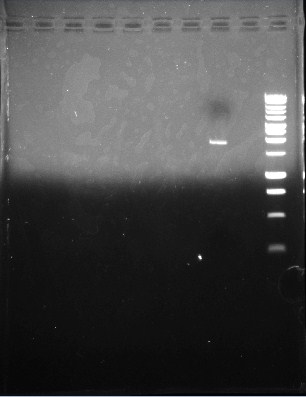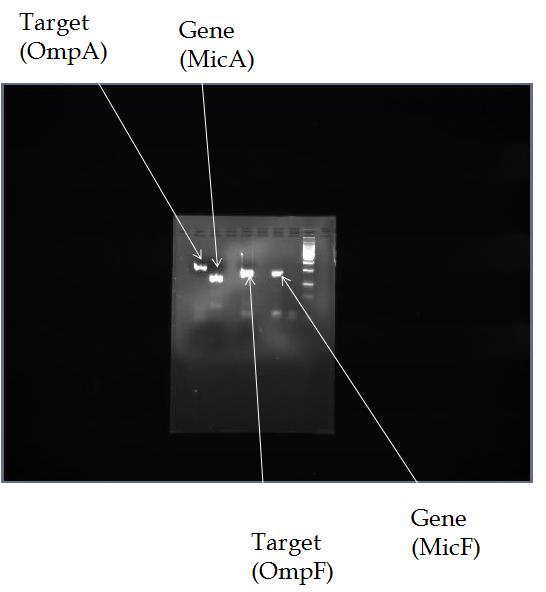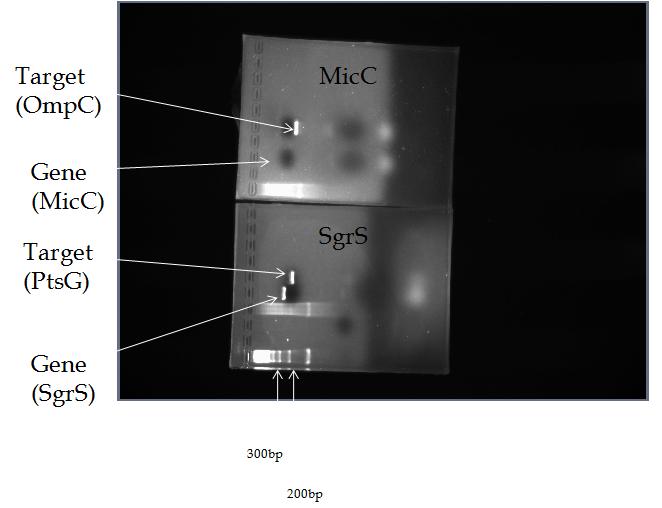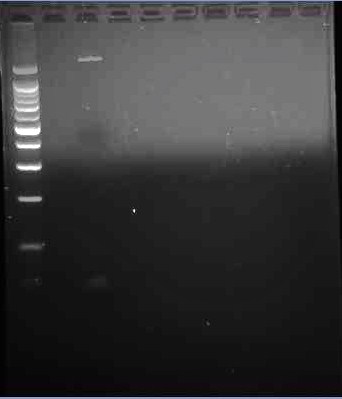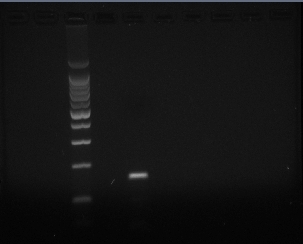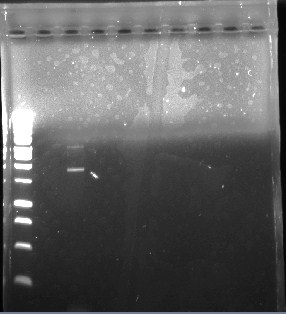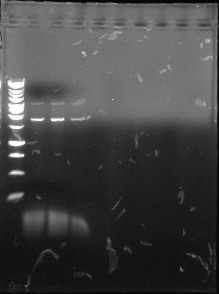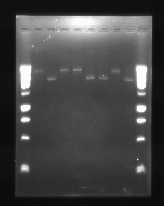Team:Illinois/sRNA Library
From 2009.igem.org
(→July 10) |
|||
| Line 64: | Line 64: | ||
[[Image:8laneligation_roomtemp.png]] | [[Image:8laneligation_roomtemp.png]] | ||
| + | |||
| + | The large, slow bands are hopefully the ligated plasmids. The ones just below that don't look like they worked. They look reasonably bright. Each lane is a variant of Insert:Vector ratio, ranging from 3:1 to 15:1 which were all ligated at room temperature for 4 hrs. (Protocol called for 1hr) | ||
Revision as of 05:17, 11 July 2009
Contents |
sRNA Library Team
Goals: Our team will be characterizing various small RNAs and submitting them to the Parts Registry as working biobricks. We will insert the sRNA gene into a high-copy plasmid and its target sequence before the GFP gene in a low-copy plasmid. We will then transform both plasmids into E. coli cells. The sRNA should successfully repress expression of the GFP gene and result in a decrease in fluorescence. We will be using a protocol documented in a paper by Urban and Vogel (please see the Protocols page).
Note: Our team split into four groups at the beginning of the summer and each team worked to get an sRNA working from the following: MicF, MicC, MicA, and SgrS. After the first week of lab work, our team split to work on things other than sRNA characterization, and the work done was resumed by the new sRNA Library team.
Click on a link below to view information pertaining to a specific sRNA, including gene sequences and primers used (early notebook entries are also included).
June 15
Each of the four sRNA groups ran two PCR reactions: one to synthesize their sRNA gene and one to synthesize the target sequence of the sRNA.
We ran a PCR for plasmid pJU-334 and ran a gel on the reaction. For some reason, the gel had a band at ~1.9kbp, rather than at 3.1kbp, where we expected the plasmid to be.
June 16
All four groups ran gels on their PCR reactions to verify that the appropriate DNA fragments had been synthesized. All PCR reactions except for the MicC gene were successful.
We ran a PCR on plasmid pJU-334 and ran a gel. The gel indicated a band at ~11kbp rather than at 3.1kbp, where the plasmid is expected to fall.
June 17
The four groups successfully added restriction endonucleases to their synthesized DNA and purified it by gel electrophoresis. The MicC gene was synthesized by PCR and verified to be successful by gel electrophoresis.
We performed a PCR on the pJU-334 plasmid and ran a gel, which indicated a faint band at ~3.1kbp (the expected size of the plasmid) and a strong band at ~1.9kbp.
June 18
We attempted another PCR of plasmid pJU-334 and ran a gel on it, using all 45 μL of the reaction. We detected a faint band at ~3.1kbp (the expected size of the plasmid) and a strong band at ~1.9kbp. We purified the ~3.1kbp band and ran another PCR on the purified DNA.
June 19
We found out that we ordered one of the wrong primers for plasmid pJU-334. We will have to order the correct primer and PCR our plasmids before we can continue.
July 10
Hopefully now the ligation will be working. After many many attempts we got a decent looking gel! The resolution isnt very good. This was an attempt to fit both the insert and the vector on the same gel but that didn't work at all. Its 1% with a 1kbp ladder.
The large, slow bands are hopefully the ligated plasmids. The ones just below that don't look like they worked. They look reasonably bright. Each lane is a variant of Insert:Vector ratio, ranging from 3:1 to 15:1 which were all ligated at room temperature for 4 hrs. (Protocol called for 1hr)
 "
"

